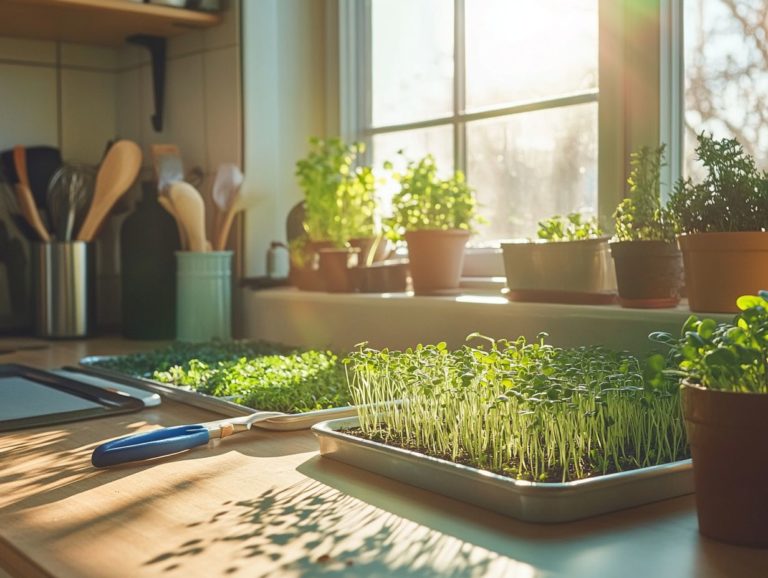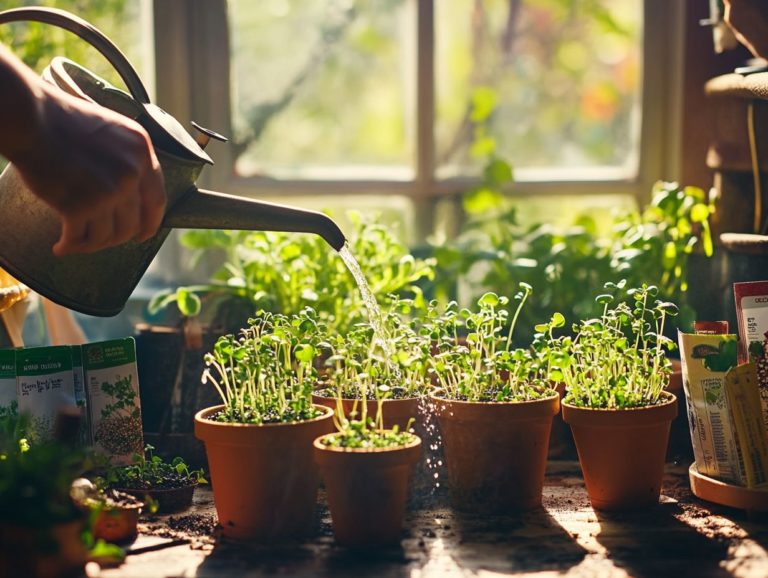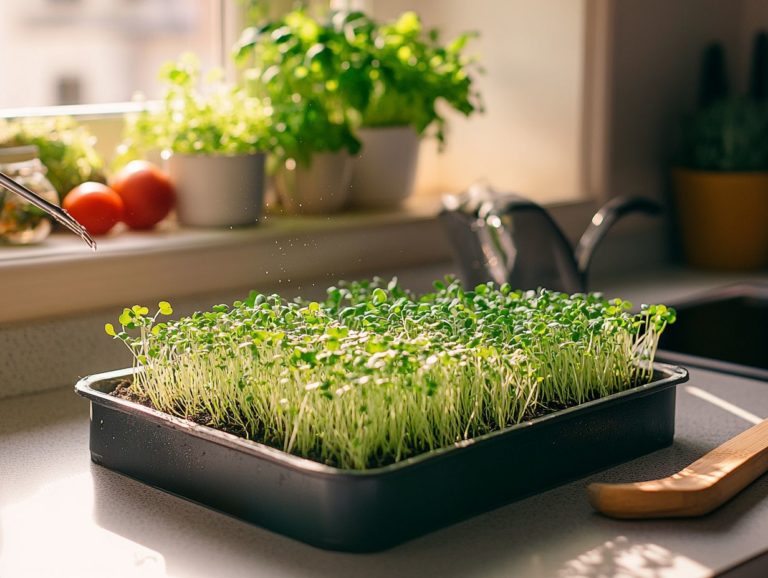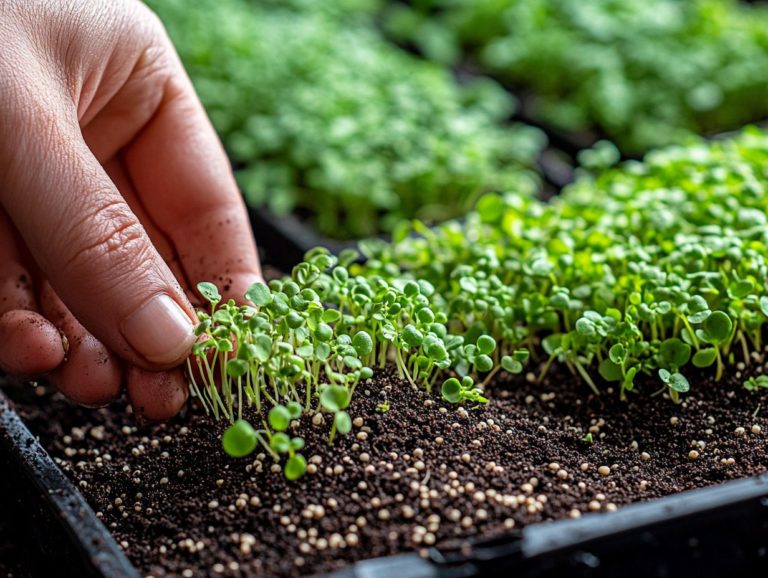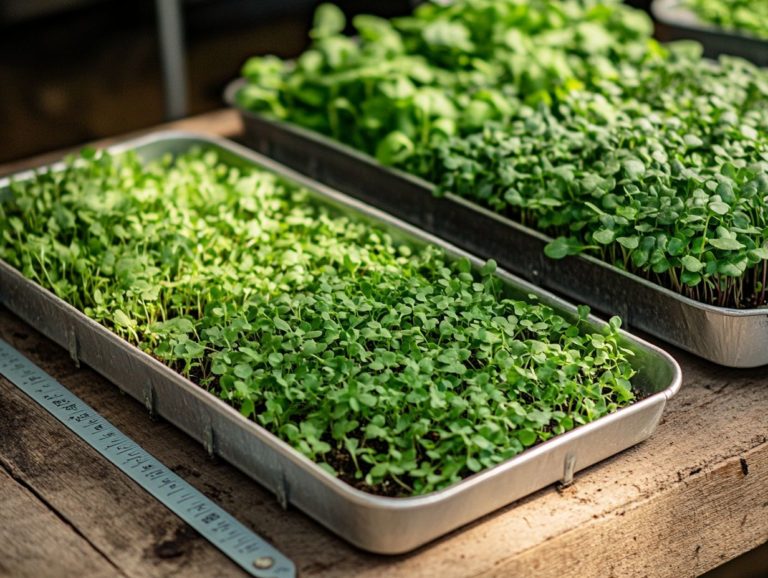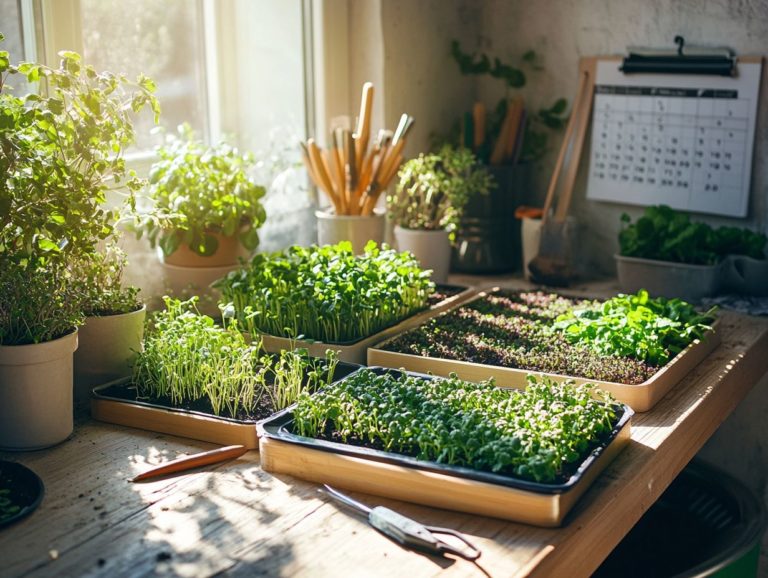How to Grow Microgreens in Small Containers
Microgreens are those delightful, nutrient-dense greens that can elevate your meals and fit effortlessly into any kitchen. They are the perfect choice for growing microgreens at home.
If you re intrigued by the idea of growing these vibrant greens at home, you ve landed in the perfect spot!
This step-by-step guide will take you through essential steps, from understanding their health benefits to selecting the ideal containers and preparing the right growing medium.
You ll find insightful planting techniques, maintenance tips, and expert advice on harvesting microgreens for maximum flavor and health benefits.
Whether you re an experienced gardener or just starting out, growing microgreens is a rewarding journey that can truly transform your culinary experience. Start growing your own fresh greens today!
Contents
- Key Takeaways:
- Benefits of Growing Microgreens
- Choosing the Right Containers
- Preparing the Growing Medium
- Planting and Caring for Microgreens
- Harvesting and Using Microgreens
- Frequently Asked Questions
- What are microgreens and why are they popular to grow in small containers?
- What type of containers can be used to grow microgreens?
- What soil should be used for growing microgreens in small containers?
- How much water do microgreens in small containers need?
- Do microgreens in small containers need sunlight?
- When should microgreens in small containers be harvested?
Key Takeaways:
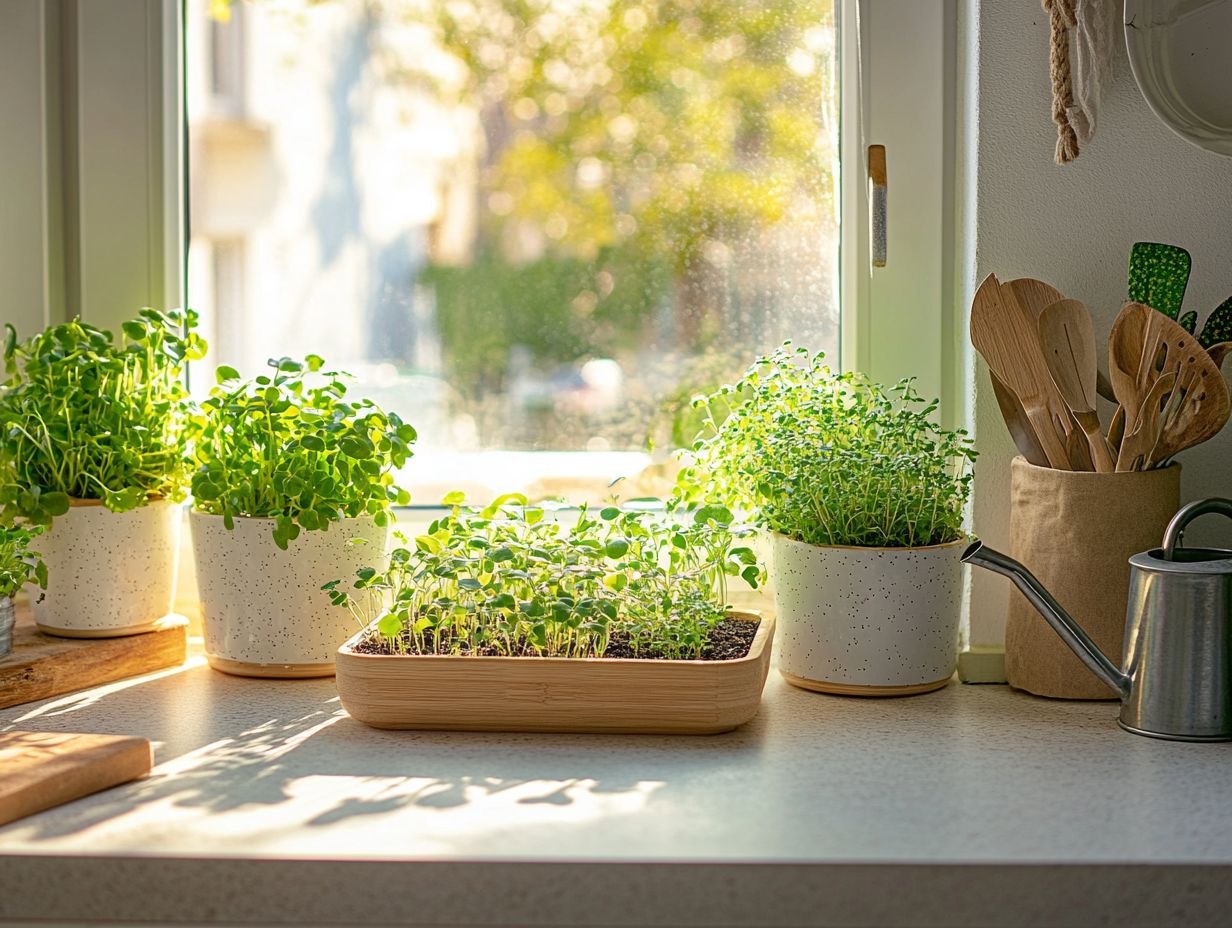
- Microgreens are nutrient-dense, easy to grow, and convenient for small living spaces.
- When choosing containers for microgreens, consider size, material, and drainage to ensure proper growth.
- To successfully grow microgreens, prepare the right growing medium and use proper planting and maintenance techniques.
What are Microgreens?
Microgreens are the young, edible plants you ll want to harvest right after the first leaves, or cotyledons, have developed. These nutrient-dense greens like broccoli, arugula, kale, and radish are not just a feast for the eyes; they also offer a wealth of health benefits, making them a great choice for anyone eager to dive into indoor gardening.
The charm of microgreens goes beyond their cooking versatility. They can elevate your salads, sandwiches, and even smoothies with their distinctive textures and flavors. With options ranging from zesty mustard greens to delicate pea shoots, these little powerhouses pack concentrated doses of vitamins, minerals, and antioxidants. For those looking to grow their own, understanding how to use a grow tent for microgreens can be incredibly beneficial. Their impressive nutrient profiles can lead to positive health benefits, including improved digestion and reduced inflammation.
Growing microgreens is a fantastic indoor gardening endeavor that requires minimal space, making it an ideal project for urban dwellers or anyone looking to infuse their meals with fresh, homegrown ingredients. Choosing the best containers for microgreen cultivation can enhance your gardening experience.
Benefits of Growing Microgreens
Growing microgreens provides a wealth of health benefits. These petite powerhouses are brimming with nutrients, including essential vitamins and antioxidants that may help lower the risk of diseases such as cancer.
Compounds like sulforaphane contribute to this protective effect, making them a valuable addition to your diet.
Nutritional Value and Convenience
Microgreens are truly a treasure trove of nutrition, offering a concentrated source of vitamins, minerals, and antioxidants that can seamlessly enhance your everyday recipes. They re an excellent choice for anyone who prioritizes health without sacrificing convenience.
These petite greens often pack more essential nutrients than fully grown ones. Research indicates that varieties like broccoli and kale microgreens contain notably higher levels of vitamins C, E, and K, along with vital phytonutrients that boost overall well-being. Their impressive nutrient density makes them a fantastic addition to salads, sandwiches, and smoothies. For those interested in growing them, exploring techniques for growing microgreens year-round can be incredibly beneficial.
For example, toss some radish microgreens into a refreshing summer salad or blend sunflower microgreens into a vibrant green smoothie. You can also explore how to use hydroponics for microgreens to grow your own. By including these tiny powerhouses in your meals, you can effortlessly enhance the nutritional profile of your dishes while savoring their fresh, earthy flavors.
Choosing the Right Containers
Choosing the right containers is essential for indoor gardening success. The type of container you select be it glass or something else plays a significant role in how well your growing medium supports microgreens.
It s not just about aesthetics; proper drainage and light conditions depend on this decision. Be sure to consider these factors carefully to nurture thriving plants.
Size, Material, and Drainage Considerations

Carefully choose your containers to set your microgreens up for success! Consider factors such as size, material, and drainage. These elements greatly impact the well-being of your plants and their ability to thrive.
The size of the container is crucial; it determines the root space available for your microgreens. This directly influences their growth rate and overall yield. A container that’s too small can restrict root development, leading to stunted growth. Conversely, an adequately sized container enhances aeration and nutrient absorption. For more tips on maximizing your gardening efforts, check out this guide on how to grow microgreens in a small space.
When it comes to materials, opt for food-safe choices like plastic, wood, or recycled components that retain moisture without sacrificing drainage. Incorporating features like drainage holes is vital. These holes allow excess water to escape, preventing root rot and creating a healthy environment for those delicate young shoots.
Proper drainage is essential for maintaining balanced moisture in the soil, enabling your microgreens to flourish.
Preparing the Growing Medium
Preparing the ideal growing medium is essential for your success in cultivating microgreens. Whether you choose traditional soil or hydroponic methods, each approach offers unique benefits that can enhance germination time and promote robust plant growth.
Choose wisely; the right medium sets the stage for thriving microgreens.
Soil vs. Hydroponic Methods
When selecting a growing medium, you ll find that both soil and hydroponics offer unique advantages for germination time. Soil provides natural nutrients, while hydroponics allows for precise control over water and nutrient delivery a method of growing plants without soil, using nutrient-rich water instead.
Soil cultivation creates a rich microbial environment that promotes healthy plant growth. Hydroponic systems can maximize space and optimize yields an especially attractive option for urban growers. However, soil may introduce pests and diseases, posing challenges for beginners. Hydroponics might also have a steep learning curve regarding nutrient systems.
For example, seeds like basil and arugula thrive beautifully in soil, taking full advantage of its organic composition. Fast-growing varieties like pea shoots and radish flourish in hydroponic setups, where tailored nutrient solutions can accelerate their growth cycles. To learn more about enhancing your results, check out this guide on how to maximize yields from microgreens.
Ultimately, your choice between soil and hydroponics will depend on your preferences, available resources, and cultivation goals. For those using artificial lighting, learning how to use grow lights for microgreens can enhance your success. Make the choice that aligns with your vision for successful microgreen gardening!
Planting and Caring for Microgreens
Successfully planting and nurturing microgreens requires you to embrace specific seeding techniques and essential maintenance tips. One critical practice is daily watering, which ensures optimal growth and well-being for these nutrient-packed greens.
By committing to these practices, you’ll cultivate a thriving microgreen garden that delivers both flavor and nutrition.
Seeding Techniques and Maintenance Tips
Applying effective seeding techniques and maintenance tips is essential for successful planting. Consistency is key; daily watering plays a significant role in the health and growth of your crops.
To achieve optimal results, focus on evenly dispersing the seeds during planting. This promotes uniform growth and minimizes competition among sprouts. For those interested in growing your own greens, learning how to grow microgreens in your kitchen can enhance your gardening skills. Planting at the right depth is equally crucial; generally, seeds should be sown just below the surface to ensure they receive adequate moisture while avoiding issues like damping-off.
Along with daily watering, maintain a regular schedule for checking moisture levels and providing sufficient light. Rotating your crops and avoiding overcrowding will lead to healthier microgreens, maximizing the return on your efforts.
Start planning your microgreen garden today for fresh flavors in your meals!
Harvesting and Using Microgreens
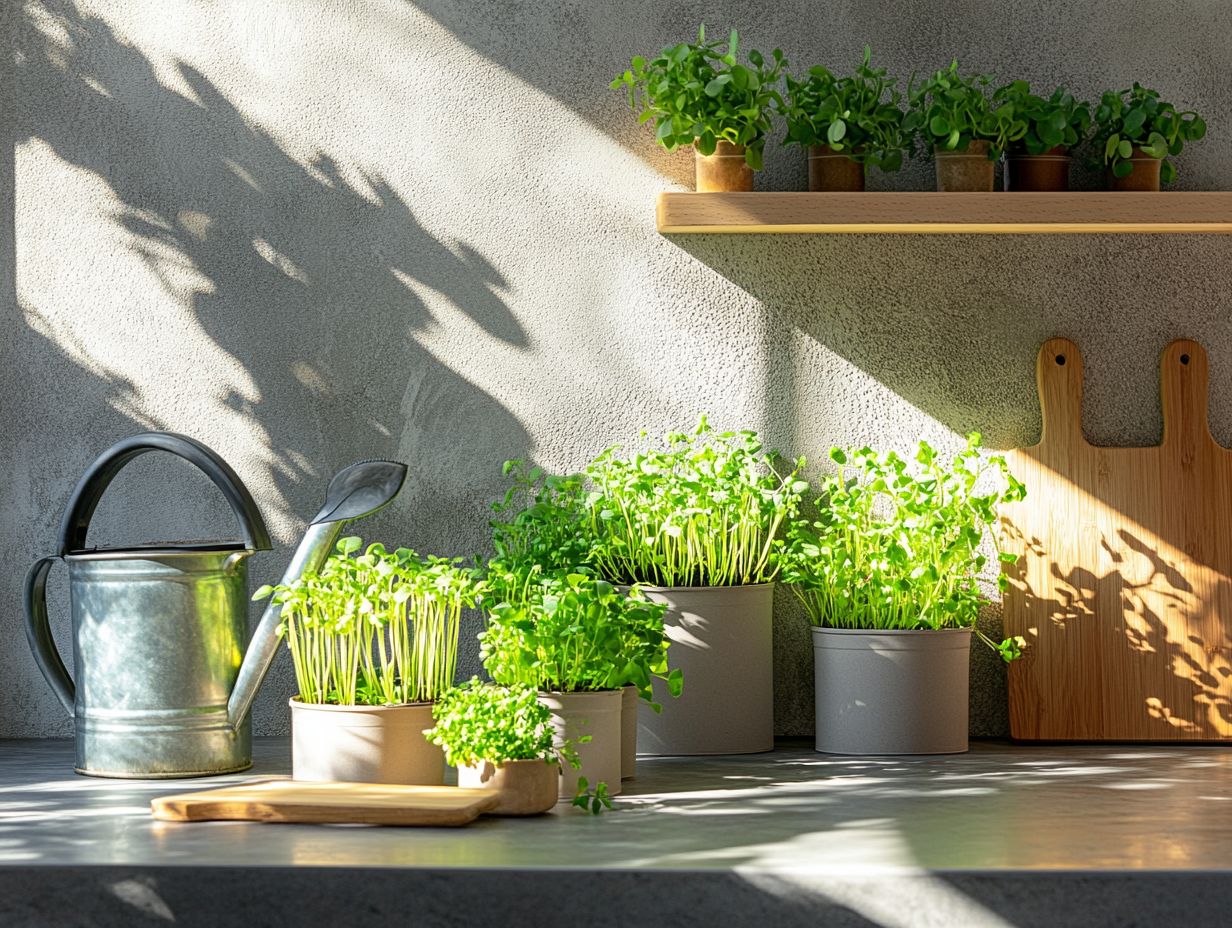
Harvesting microgreens at the perfect moment is crucial for unlocking their full flavor and nutritional potential. This careful timing allows you to incorporate these vibrant greens into a range of dishes and simple recipes that elevate both taste and health benefits.
When and How to Harvest for Optimal Flavor and Nutrition
To unlock the full flavor and nutritional potential of your microgreens, you must know the perfect time for harvesting. Generally, this occurs just a few weeks after germination, when those leaves are at their most vibrant and tender. They make excellent additions to your diet.
During this fleeting period, your microgreens will flaunt their bright colors and reach a peak in essential nutrients, enhancing their robust flavor profile. As you watch these little plants grow well, look for specific indicators. The emergence of the first true leaves signals that it’s time to harvest. For a detailed approach, refer to our step-by-step guide to sowing microgreens. Pay attention to their height and leaf structure; taller microgreens can sometimes take on a bitter edge and lose that delightful texture.
By harvesting at just the right moment, you ensure a flavorful burst while maximizing their health benefits, making them a stellar addition to a variety of dishes.
Ways to Incorporate Microgreens into Meals
Adding microgreens to your meals is an exciting way to elevate both flavor and health. These nutrient-dense greens can seamlessly blend into salads, sandwiches, and smoothies, making them an incredibly versatile addition to your culinary repertoire.
Imagine tossing a handful of radish microgreens into a fresh garden salad. Not only do they impart a peppery kick, but they also significantly enhance the vitamin content. If you’re interested in growing your own, check out this guide on how to start a microgreen garden for beginners. They can transform avocado toast, adding a satisfying crunch and vibrant color, making your meal not only healthy but visually stunning as well.
Consider blending sunflower microgreens into your morning smoothie for a delightful nutty flavor, all while reaping the antioxidant benefits. These little greens also serve as an excellent garnish for soups and main dishes, such as a creamy tomato basil soup, where they provide a fresh burst of flavor and invaluable nutrients in every spoonful.
Frequently Asked Questions
What are microgreens and why are they popular to grow in small containers?
Microgreens are vibrant, young greens packed with flavor and nutrients. They are popular to grow in small containers because they require minimal space and can be grown indoors year-round.
What type of containers can be used to grow microgreens?
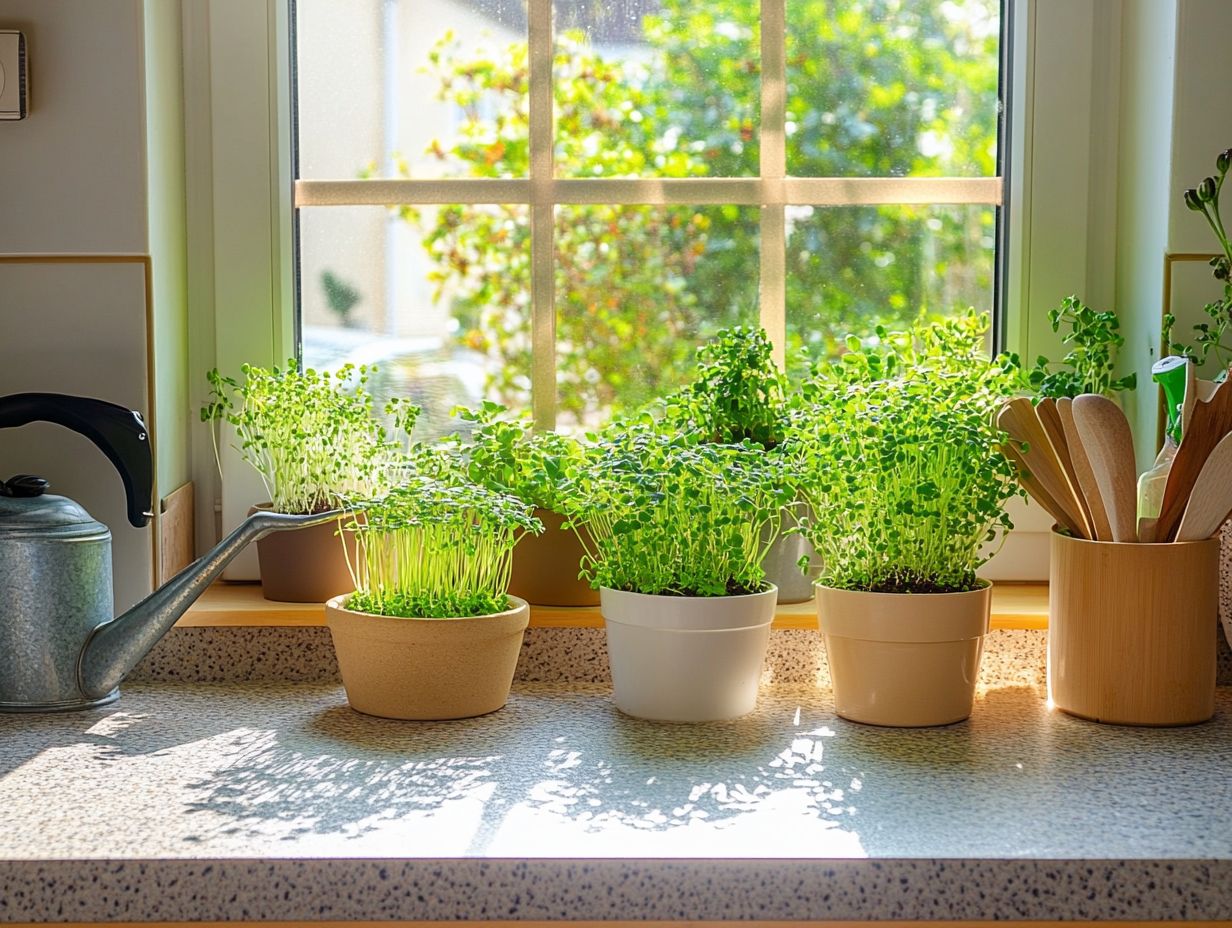
Microgreens can be grown in a variety of containers, such as shallow trays, small pots, or even recycled containers like egg cartons or takeout containers. Just make sure the containers have drainage holes for proper water drainage.
What soil should be used for growing microgreens in small containers?
A lightweight, sterile potting mix or seed starting mix is best for growing microgreens in small containers. Avoid using garden soil, as it may contain pests or diseases that can harm your microgreens.
How much water do microgreens in small containers need?
Microgreens require consistent moisture but not water-logging. A good rule of thumb is to keep the soil moist but not soggy. Watering once a day should be sufficient, but monitor the soil moisture and adjust as needed.
Do microgreens in small containers need sunlight?
Yes, microgreens need sunlight to grow. Place your containers near a sunny window or use a grow light to provide adequate light for your microgreens. Rotate the containers every few days to ensure even growth.
When should microgreens in small containers be harvested?
Microgreens can be harvested when the first true leaves have developed, usually 1-3 weeks after planting. Use clean scissors to cut the greens just above the soil level. You can harvest the entire crop or just cut off what you need and let the rest continue to grow.

